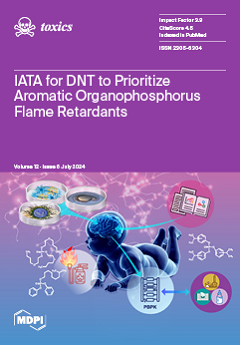This study utilizes
Mentha piperita (MI) for the first time to investigate the uptake and translocation of chlorpyrifos (CPF; 10 µg g
−1) from soil, introducing a new approach to improve the efficacy of this technique, which includes using biosurfactants (
Bacillus
[...] Read more.
This study utilizes
Mentha piperita (MI) for the first time to investigate the uptake and translocation of chlorpyrifos (CPF; 10 µg g
−1) from soil, introducing a new approach to improve the efficacy of this technique, which includes using biosurfactants (
Bacillus subtilis and
Pseudomonas aeruginosa) at 10
7 CFU/mL to degrade CPF under greenhouse conditions. Moreover, antioxidant enzymes, including superoxide dismutase (SOD) and peroxidase (Prx), and oxidative stress due to hydrogen peroxide (H
2O
2) and malondialdehyde (MDA) in MI roots and leaves were evaluated under CPF stress. Our results demonstrated that amending soil with MI and
B. subtilis followed by
P. aeruginosa significantly reduced CPF levels in the soil (
p > 0.05) and enhanced CPF concentrations in MI roots and leaves after 1, 3, 7, 10, and 14 days of the experiment. Furthermore, CPF showed its longest half-life (t
1/2) in soil contaminated solely with CPF, lasting 15.36 days. Conversely, its shortest half-life occurred in soil contaminated with CPF and treated with MI along with
B. subtilis, lasting 4.65 days. Soil contaminated with CPF and treated with MI and
P. aeruginosa showed a half-life of 7.98 days. The half-life (t
1/2) of CPF-contaminated soil with MI alone was 11.41 days. A batch equilibrium technique showed that
B. subtilis is better than
P. aeruginosa for eliminating CPF from soil in In vitro experiments. Notably, CPF-polluted soil treated with coadministration of MI and the tested bacteria improved the activities of SOD and Prx and reduced H
2O
2 and MDA compared with CPF-polluted soil treated with MI alone. Our findings demonstrated that using
B. subtilis and
P. aeruginosa as biosurfactants to augment phytoremediation represents a commendable strategy for enhancing the remediation of CPF contamination in affected sites while reducing the existence of harmful pesticide remnants in crop plants.
Full article






